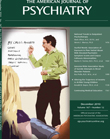Hurtful Words: Association of Exposure to Peer Verbal Abuse With Elevated Psychiatric Symptom Scores and Corpus Callosum Abnormalities
Abstract
Objective:
Previous studies have shown that exposure to parental verbal abuse in childhood is associated with higher rates of adult psychopathology and alterations in brain structure. In this study the authors sought to examine the symptomatic and neuroanatomic effects, in young adulthood, of exposure to peer verbal abuse during childhood.
Method:
A total of 848 young adults (ages 18–25 years) with no history of exposure to domestic violence, sexual abuse, or parental physical abuse rated their childhood exposure to parental and peer verbal abuse and completed a self-report packet that included the Kellner Symptom Questionnaire, the Limbic Symptom Checklist–33, and the Dissociative Experiences Scale. Diffusion tensor images were collected for a subset of 63 young adults with no history of abuse or exposure to parental verbal abuse selected for varying degrees of exposure to peer verbal abuse. Images were analyzed using tract-based spatial statistics.
Results:
Analysis of covariance revealed dose-dependent effects of peer verbal abuse on anxiety, depression, anger-hostility, dissociation, “limbic irritability,” and drug use. Peer and parental verbal abuse were essentially equivalent in effect size on these ratings. Path analysis indicated that peer verbal abuse during the middle school years had the most significant effect on symptom scores. Degree of exposure to peer verbal abuse correlated with increased mean and radial diffusivity and decreased fractional anisotropy in the corpus callosum and the corona radiata.
Conclusions:
These findings parallel results of previous reports of psychopathology associated with childhood exposure to parental verbal abuse and support the hypothesis that exposure to peer verbal abuse is an aversive stimulus associated with greater symptom ratings and meaningful alterations in brain structure.



